


The Gollierplatz is a square in Munich's Westend district. [1]



The Gollierplatz is a square in Munich's Westend district. [1]
The Gollierplatz extends in an east-west direction between Trappentreustraße and Bergmannstraße on an area of approx. 10,000 m².
Since 1897, the square has borne the name of a Munich patrician family, presumably extinct since 1318. [2]
Located in the heart of the Westend residential district, Gollierplatz is a prominent example of Munich urban planning around 1900. Originally planned as a regular geometric element in net-like alignment, the square and its surroundings were redesigned in 1892 following a city expansion competition. The south side in particular was loosened up and provided with views in the direction of Kiliansplatz. Due to the later development of closed, monumental residential complexes, the square once again developed in a different direction and it was transformed from picturesque into a strict practicality. [3]
One of the first buildings in the squares south side was the two-wing school built by Carl Hocheder between 1889 and 1891. From 1901 to 1903, Gabriel von Seidl built the parish church of St. Rupert to the west of the school building in a neo-Romanesque style. [4] It was not until 1926 that Ludwig Naneder added the parsonage with its hipped roof. In 1902 the striking corner house Kiliansplatz 6 with two staggered gables and a corner oriel in Neo-Renaissance style was built. At the beginning of the 20th century, several apartment buildings in late Art Nouveau style followed on the north side of Gollierplatz.
After the end of the First World War, the northern side of the square between Ganghoferstraße, Geroltstraße and Bergmannstraße to Naneder was closed off with several monumental apartment blocks. Even larger residential complexes with inner courtyards were built on the south side between Gollierstraße, Kazmairstraße, Geroltstraße and Ganghoferstraße in the 1920s style. From 1925 to 1927, Theodor Fischer's Ledigenheim (home for single people), [5] one of Munich's most important buildings in the early New Objectivity style, built in brick construction to the southeast. From 1930 to 1931, German Bestelmeyer oriented his Protestant-Lutheran Church of the Resurrection and the associated vicarage towards the Fischersche Ledigenheim.
The Vier-Nymphen-Brunnen (Four Nymphs Fountain ) by Elmar Dietz has been located on the eastern part of the square since 1938. [6]
The individual buildings of the square are historically listed, the square is registered as an ensemble of buildings.
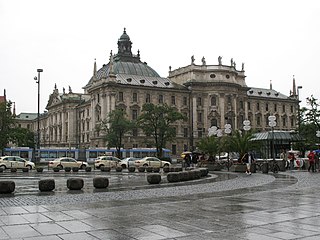
Stachus is a large square in central Munich, southern Germany. The square was officially named Karlsplatz in 1797 after the unpopular Charles Theodore, Elector of Bavaria. Munich natives seldom use that name, calling the square instead Stachus, after the pub Beim Stachus, once owned by Eustachius Föderl, that was located there until construction work for Karlsplatz began. Even the U-Bahn and S-Bahn announcements use the unofficial name.

Königsplatz is a square in Munich, Germany. Built in the style of European Neoclassicism in the 19th century, it displays the Propyläen Gate and, facing each other, the Glyptothek and the Staatliche Antikensammlungen. The area around Königsplatz is home to the Kunstareal, Munich's gallery and museum quarter.

The New Town Hall is a town hall at the northern part of Marienplatz in Munich, Bavaria, Germany. It hosts the city government including the city council, offices of the mayors and a small portion of the administration. In 1874 the municipality had left the Old Town Hall for its new domicile.

The Prinzregentenstraße in Munich is one of four royal avenues and runs parallel to Maximilianstraße and begins at Prinz-Carl-Palais, in the northeastern part of the Old Town. The avenue was constructed from 1891 onwards as a prime address for the middle-class during the reign of Luitpold, Prince Regent of Bavaria and is named in his honour. The square in the eastern part of the street is named Prinzregentenplatz.

Haidhausen is a quarter of Munich, Germany. It is now part of the borough—or stadtbezirk—number 5 Au-Haidhausen.
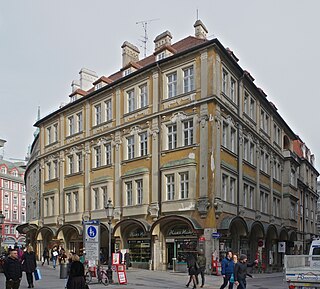
The Ruffinihaus is a group of three houses on the Rindermarkt 10 in the Old Town of Munich, Germany. It was built by Gabriel von Seidl from 1903 to 1905 and is named after the Ruffiniturm, which in turn was named after Johann Baptista Ruffini. The Ruffiniturm formed the original Sendlinger Tor and thus was part of Munich's first city wall. The three-sided house that borders the Sendlinger Street and Pettenbeck Street stands on what was the fluvial terrace of the first medieval fortification's moat, as can still be seen today when viewed from the southeast. This is a prominent site by virtue of both being a historical location and marking the transition point between the oldest core of the city and its first expansion in the 13th century. The Bavarian Office of Monument Preservation describes the building as "romantic-native mood architecture of the highest level for the interpretation of a historicist image of an old town as seen under a picturesque ideal, which was meant to be 'upgraded'."
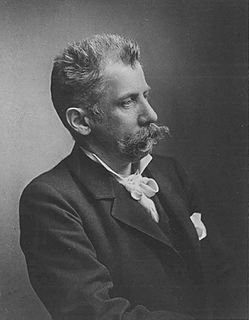
Gabriel von Seidl was a German architect and a representative of the historicist style of architecture.

Unser Lieben Frauen Kirchhof is a central square in Bremen between the Bremer Marktplatz, Obernstraße, Sögestraße and the Domshof. The square is used as a flower market. The appearance of the square is quite consistent: sandstone, dark brick and clinker brick.
The Tulbeckstraße is a street in Munich and lies west of the city center in the district Schwanthalerhöhe. It leads from Parkstraße in the east to Trappentreustraße in the west. It was named after the Munich patrician family Tulbeck in 1878. From this family came the Freising Prince-Bishop Johann IV Tulbeck.

Maria-Josepha-Straße is a street in Munich's Schwabing district. It runs west of the Englischer Garten from Dillisstraße, or the Nikolaiplatz to the corner of Mandlstraße/Königinstraße, and forms the southern edge of the heritage-protected building ensemble Alt-Schwabing. The name of the street came from Maria Josepha of Portugal, the second wife of Karl Theodor, Duke in Bavaria. The renaming of the street from its originally name, Wiesenstraße, took place in the course of 1891 and was carried out with the incorporation of Schwabing to Munich. Countless streets of the Altschwabinger village center were then given new addresses and names. According to Rambaldi, the street name assignments were officially carried out as early as 1890, and for the postal detection of the buildings along this road, the name had been recognized since 12 November 1892. On city maps from the years 1890 and 1891, the street name was not yet to be found.
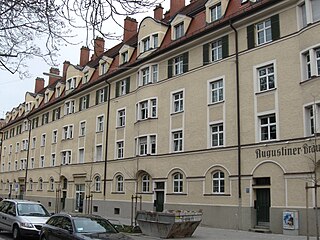
The Bergmannstraße is a street in Munich and lies west of the city center. It leads from Landsberger Straße in the north to Ridlerstraße in the south and is located in the district of Schwanthalerhöhe. The formerly referred to as Sendlinger way road, was named in 1883 after the lawyer, historian and archivist Michael Adam von Bergmann (1733-1783), who was city chief judge starting in 1762 and then became mayor in Munich.

The Königinstraße is a street in Munich. It runs west of the Englischer Garten from the Von-der-Tann-Straße in the district of Maxvorstadt, to the north and to the Maria-Josepha-Straße and Mandlstraße in the Ensemble Alt-Schwabing.

Angertorstraße 3 is an apartment building in Munich, Germany that is a registered Bavarian historical monument.

The Trappentreustraße is a street in the west of Munich and part of the Mittlerer Ring.

The Lindwurmstraße is a 2.4-kilometer poplar alley in the Munich districts Ludwigsvorstadt-Isarvorstadt and Sendling.
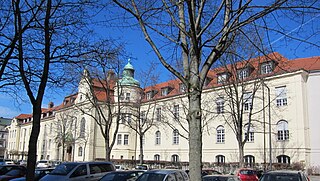
The Holbeinstraße is a city center street in the Munich district of Bogenhausen.

The Ismaninger Straße is a city center, entrance and exit road in Munich.

Boschetsrieder Straße is an inner city street in the Munich districts of Thalkirchen, Obersendling and Forstenried/Am Waldfriedhof, which runs west from Bundesstraße 11 on the Isar hillside to Kreuzhof, where it continues as the Fürstenrieder Straße.

Kurfürstenplatz is a square in the Munich district of Schwabing and is located about two and a half kilometres north of the city centre. It is the intersection of several streets and tram lines and was built in 1915 and named after the Elector Maximilian II. Emanuel, born in Munich in 1662.
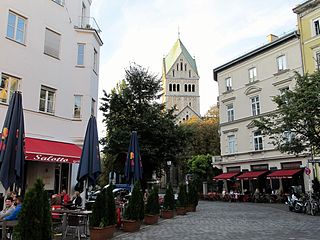
The St. Anna Platz is a square in Munich. It is registered as a listed ensemble in the Bayerische Denkmalliste.
| Wikimedia Commons has media related to Gollierplatz . |